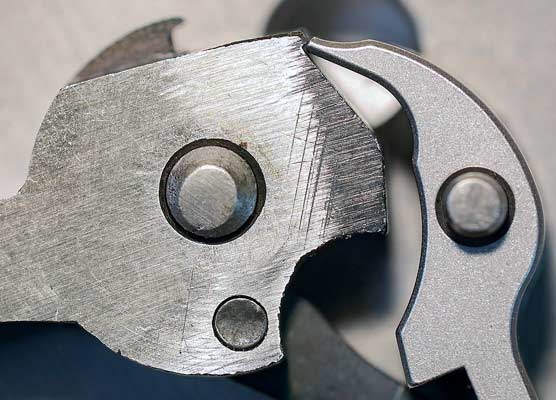Discover | Handloading |
0
As handloaders here in the second decade of the 21st century, we are indeed blessed to have so many choices in .38/.357 bullet designs. When I’m going to shoot extensively, I normally turn to my home-cast bullets, however I have certainly used thousands of jacketed bullets as well as commercial cast bullets in .38 Special and .357 Magnum sixguns.
When it comes to jacketed bullets my most used version is the Hornady 125-gr. XTP-JHP. This bullet does double duty as it is my choice for use in either .38 Special or .357 Magnum brass in several small-frame pocket pistols. With standard loads in the .357 Magnum, you can’t go wrong choosing 158-gr. jacketed bullets from Hornady, Sierra or Speer. I have also used thousands of Oregon Trail 158-gr. hardcast SWCs.
Left to right: The Lyman #358311, 158-gr.; RCBS #38-150KT, 155-gr.;
Lyman/Keith #358429, 168-gr. and Lyman/Thompson #358156GC, 155-gr.
By the fall/winter of 1956/1957, I had pair of .357 Magnums, a Ruger 45/8″ Flat-Top Blackhawk and a Smith & Wesson 4″ Highway Patrolman. Brass was almost impossible to find in .357 Magnum, however since this was a time bull’s-eye shooting was king, .38 Special brass was readily available and cheap. My first bullets for use in the two guns were the Lyman roundnosed #358311 and the Lyman Keith #358429. These were cast in single-cavity molds and then lubed and sized by hand, which added to the slow process of reloading with the Lyman #310 hand tool. Today, four cavity molds and progressive presses make things much more efficient and pleasant.
The Keith bullet was designed by Elmer for use in the .38 Special S&W .38/44 Heavy Duty. Meanwhile, Col. Doug Wesson and Phil Sharpe were secretly working on the .357 Magnum. This was in the early ’30s. When the .357 Magnum arrived it was found seating the Keith bullet by crimping in the crimping groove in the new longer magnum brass resulted in a load whose overall length was too long for the cylinder of the S&W .357 Magnum.
This made .38 Special brass all the more attractive. Today I simply crimp over the front shoulder on the Keith bullet when using .357 Magnum brass in short-cylinder sixguns. The S&W Combat Magnum, the Model 19 now, was the first S&W double-action sixgun to have a cylinder long enough to use the Keith bullet properly crimped in magnum brass. Phil Sharpe had also designed a bullet with a shorter nose for use in the .357 Magnum cylinders, and this is basically duplicated today by RCBS with their excellent #38-150KT.
Left to right: The Lyman #358311 and loaded in .38 Long Colt, .38 Special and .357 Magnum.
The RCBS #38-150KT loaded in .38 Super, .38 Special and .357 Magnum.
Left to right: The Lyman/Thompson #358156GC loaded in .38 Special,
loaded in .38 Special using bottom crimp groove and loaded in .357 Magnum.
The Lyman/Keith #358429 loaded in .38 Special, crimped over front band
in .357 Magnum and using crimp groove in .357 Magnum.
One of the real problems associated with early Magnum loads was leading. Jacketed bullets were unavailable and the cast bullets were often too soft. Bullet genius Ray Thompson came up with a solution — gas check bullets. The cast bullet accepts a copper cap on the specially designed base. Thompson’s #358156, which is still available from Lyman, not only incorporates the gas check but it also has two crimping grooves. For my use the top groove is used for .357 Magnum loads while the bottom groove is normally the choice when loading .38 Special brass. This is my most used .38 bullet in .357 loads, while the Keith #358429 handles most of my .38 Special and .38/44 chores.
For my use with the hard cast #358429 bullet in .357 Magnum brass, I use 14.0 to 15.0 grs. of #2400, however this is normally cut to 12.5 grs. for use in .38 Special brass and then shot only in .357 Magnum sixguns in excellent condition. This bullet has stood the test of time and for my use is second only to the Thompson bullet when it comes to number of rounds loaded and shot every year.
Switching to Thompson’s bullet in .357 Magnum cases I use the same charges, however in .38 Special brass I use the original Keith load with bullets crimped in the bottom crimping groove, which lowers velocity but also lowers pressure. Bullet #3 of choice is the above-mentioned RCBS #38-150KT. This plain-based bullet is now joined by a gas check version of same, which is the RCBS #38-158SWC.
When trying to develop .357 Magnum level loads for use in both sixgun and leverguns you can avoid a lot of grief by going straight to gas check bullets. The Thompson bullet has been an excellent performer in both sixguns and leverguns, while plain base bullets often give mediocre results in long guns. I would expect the latest RCBS gas check design to also work well in leverguns.
By John Taffin
For more info: www.americanhandgunner.com/product-index and click on the company name.
Read More Handloading Articles

Purchase A PDF Download Of The American Handgunner Sept/Oct 2013 Issue Now!


